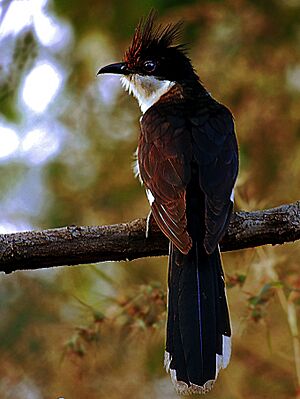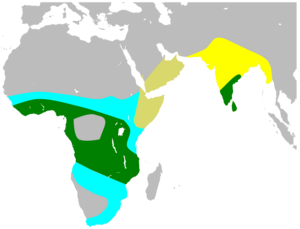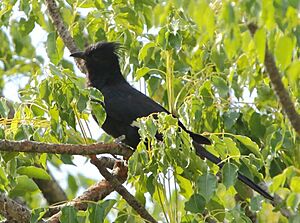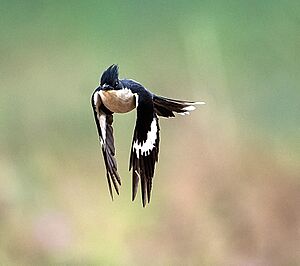Jacobin cuckoo facts for kids
Quick facts for kids Jacobin cuckoo |
|
|---|---|
 |
|
| An adult (India) | |
| Conservation status | |
| Scientific classification | |
| Genus: |
Clamator
|
| Species: |
jacobinus
|
 |
|
| dark green - year round yellow - summer only blue - winter cream - passage only |
|
| Synonyms | |
|
Oxylophus jacobinus |
|
The Jacobin cuckoo (Clamator jacobinus), also known as the pied cuckoo or pied crested cuckoo, is a type of cuckoo bird. You can find these birds in parts of Africa and Asia. They are partially migratory, meaning they move between places. In India, people often think of them as a sign that the monsoon rains are coming. This is because of when they arrive each year. The Jacobin cuckoo is even linked to a bird in Indian stories and poems. This mythical bird is called the chātaka (Sanskrit: चातक). It's shown as a bird with a special beak that waits only for rain to drink.
Contents
Naming the Jacobin Cuckoo
Scientists give every living thing a unique name. This helps everyone know exactly which plant or animal they are talking about. The Jacobin cuckoo got its scientific name, Cuculus jacobinus, in 1783 from a Dutch scientist named Pieter Boddaert. He based the name on earlier drawings and descriptions.
What Do the Names Mean?
The current group name for the Jacobin cuckoo is Clamator. This comes from a Latin word meaning "shouter." It fits because these birds are quite noisy! The name jacobinus and the English name "Jacobin" refer to the bird's black and white feathers. These colors look a bit like the clothes worn by monks of the Dominican Order. In France, these monks were called "Jacobins."
Different Types of Jacobin Cuckoos
There are three main types, or subspecies, of Jacobin cuckoos. They live in different areas:
- C. j. serratus (Sparrman, 1786) – Found in South Africa and southern Zambia.
- C. j. pica (Hemprich & Ehrenberg, 1833) – Lives in Africa south of the Sahara Desert, reaching north Zambia and Malawi. It also lives in northwest India, Nepal, and Myanmar.
- C. j. jacobinus (Boddaert, 1783) – Found in southern India, Sri Lanka, and southern Myanmar.
What the Jacobin Cuckoo Looks Like

The Jacobin cuckoo is a medium-sized bird. It is slender and has black and white feathers with a crest on its head. You can easily spot it because of the white patch on its black wings and its unique feather pattern. Even when it's flying, these features make it easy to recognize.
These birds are very loud, especially during their breeding season. Their call sounds like a ringing series of whistling notes, often described as "piu-piu."
Color Variations
In Africa, some Jacobin cuckoos have two different color forms. One is the "pied phase," which means they are mostly white or whitish underneath. The other is the "black phase," where almost their entire body is black, except for the white patch on their wings. Birds of the same color phase tend to mate with each other. Sometimes, a rare all-rufous (reddish-brown) color phase has been seen in Central Africa.
Where Jacobin Cuckoos Live
These cuckoos live in Africa, south of the Sahara Desert. They are also found in Asia, south of the Himalayas, including Sri Lanka and parts of Myanmar. While some populations stay in one place, others migrate. For example, the cuckoos in eastern Africa often fly across southern Arabia to India in April.
Jacobin cuckoos prefer certain types of places to live. They mostly like thorny, dry scrublands or open woodlands. They tend to avoid dense forests or very dry desert areas.
Life and Habits of the Jacobin Cuckoo
During the breeding season, male Jacobin cuckoos will call from high places to attract mates. They also chase each other, flying with slow wing beats that sometimes sound like pigeon claps.
Laying Eggs in Other Birds' Nests
The Jacobin cuckoo is a "brood parasite." This means it lays its eggs in the nests of other bird species, instead of building its own nest and raising its own young. In India, they often choose the nests of babblers, which are birds from the Turdoides family. The cuckoo's eggs are usually turquoise blue, matching the color of the host bird's eggs. They are also a bit bigger than the eggs of common babblers.
Sometimes, they lay white eggs in the nests of other hosts, like the red-vented bulbul. The cuckoo lays its eggs very quickly, usually in the morning. It might even drop the egg into the nest from above, sometimes cracking one or more of the host's eggs. In Africa, the male cuckoo might distract the host bird while the female quickly lays her egg. Sometimes, more than one cuckoo egg can be found in a single nest, and two young cuckoos have been known to successfully grow up together in the same nest.
Cuckoo Chicks and Their Hosts
When a young cuckoo hatches, its skin changes color from pink to purplish-brown within a couple of days. Unlike some other cuckoo species, Jacobin cuckoo chicks do not push the host's eggs or chicks out of the nest. However, they often get most of the attention and food from the parent birds. This can sometimes lead to the host's own chicks not getting enough food and starving. Babblers often raise their young as a group, so a cuckoo chick might be fed by several adult babblers.
What They Eat
Jacobin cuckoos mainly eat insects. This includes hairy caterpillars, which they pick up from the ground or nearby plants. Before swallowing caterpillars, they often squeeze them from end to end to remove their insides. They also sometimes eat fruits.
Predators
Sometimes, Jacobin cuckoos can become prey for other birds. The Eurasian sparrowhawk (Accipiter nisus) has been seen attacking these cuckoos. The sparrowhawk might force the larger cuckoo to the ground with its claws, then use its hooked beak to tear at it.
The Jacobin Cuckoo in Culture
This bird is often mentioned in old Indian poems as the chātaka. In Indian stories, the chātaka is a bird with a beak on its head that only drinks rainwater. The famous poet Kalidasa used this bird in his poem "Meghadoota" to show a deep longing for something. This idea of the chātaka as a symbol of yearning continues in many literary works.
However, some people have noted that in certain parts of India, like Bengal, the bird called "chataka" might actually refer to the common iora or even skylarks, not always the Jacobin cuckoo.
Images for kids




